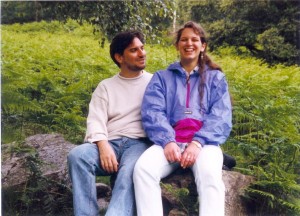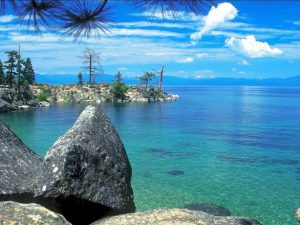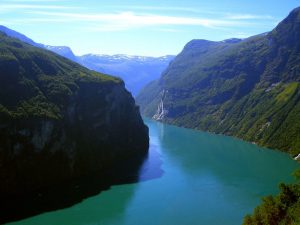For my 25th birthday, our good friend Mike took Electra and me for hill-climbing to the McDonalds stronghold outside of Edinburgh. On our way there, we passed two streams, which Mike identified as Glen Doom and Glen Sorrow.
Their charming names notwithstanding, I wondered what the difference between a glen and a stream is. Some 20 years later, I finally have my answer, courtesy of Meg Neal of Atlas Obscura. who has compiled 58 different ways of describing bodies of water,
Size Matters: Starting Small
As Meg explains, the distinction between the various terms is usually defined by size. As the old adage goes:
you can step over a brook, jump over a creek, wade across a stream and swim across a river.
To describe a small stream, you might use any of the following:
- A stream (#1) tends to be the generic term for flowing water; a
- a river (#2) is the largest, while a
- a creek (#3) is a small stream and
- a brook (#4) is even smaller and often babbling.
- Beyond that, small streams can be described as a rivulet (#5, a very small stream or baby stream),
- a rill (#6, a very small brook or rivulet),
- a beck (#7, yet another name for small stream),
- a kill (#8, an old Dutch term in colonial New York for creek or stream),
- a streamlet (#9, yep, a small stream,),
- a runnel, also called runlet, run, rundle or rindle (#10, again, a small stream or brook or rivulet),
- a brooklet (#11, a small brook),
- a bourn (#12, a small stream, particularly one that flows intermittently or seasonally),
- a beck (#13, a small river or synonym for stream or brook),
- a crick (#14, a variation in the pronunciation of creek in parts of the U.S.),
- a ghyll (#15, a narrow stream or rivulet, or a ravine through which through small stream flows), and
- a syke or sike (#16, another Old English term for small stream, especially one that is dry in summer).
A Larger Stream
What about a large stream?
- In Scotland and England, that’s sometimes called a burn (#17).
- A spring (#18) is when water flows up from under the ground to the surface.
- A bayou (#19) is very slow moving water, generally a tributary of a lake or river that is sluggish and marshy and filled with vegetation.
- A tributary (#20) for that matter is any stream that flows into a larger main stream or river, while
- a distributary (#21) is the opposite: a stream that branches off from the main river and flows away from it.
- A meander (#22) is just what it sounds like, a turn or bend in a winding river.
- A freshet (#23) is a sudden flow of freshwater from rapid heavy rain or melting snow after a spring thaw. (It can also mean the place where a river or stream empties into the ocean, combining freshwater into salt water.)
- In the same realm, an estuary (#24) is where a river empties into the sea—the place where the mouth of the river meets out the ocean tide.
- And the headwaters (#25) is the source, the very beginning of a river or stream.
Surrounded by Land
There is sweeping category of bodies of water that are either partially or entirely surrounded by land. The former is often found in coastal areas where the shoreline curves in, like a long broad indentation, so the sea is partially surrounded by land but with a wide mouth connected to the open ocean.
- A gulf (#26) is the largest of these broad inlets, and tends to have a narrow mouth opening to the sea.
- Smaller than a gulf is a bay (#27) which is also largely landlocked but with a wider mouth. Smaller still we call a
- Smaller still we call a cove (#28), a small recess or indent in the shoreline that forms a sheltered nook with a narrow entrance.
- A cove will have just a narrowing opening to the sea, while a bight (#29) is a wide indent of the shore, like a bay but smaller and broader—these bights were historically a perfect safe harbor for pirates.
- Speaking of harbors (#30) these are defined as any area of water where ships can anchor and be sheltered from the rough waters and winds of the open ocean.
- That’s slightly different than a port (#31), which are specifically defined as any geographical area where ships are loaded and unloaded. In a similar vein, a sheltered body of water near the shore but slightly outside the enclosed harbor is sometimes called
- a roadstead or roads (#32). Here, ships anchor while they wait to enter the port.
- We all know the common term for a large body of water surrounded by land on all sides; that would be a lake (#33).
- A pond (#34) is just a smaller version, and often formed artificially.
- A particularly shallow but broad sheet of standing water is sometimes referred to as a mere (#35), particularly in Old English dialects or literature.
- Even smaller and shallower is a puddle (#36), typically consisting of dirty rainwater.
- On the flip side, a deep body of still freshwater forms a pool (#37).
- And a tarn (#38) is a small pool or lake found in the mountains, sometimes with steep banks formed by a glacier.
- Things get interesting when the body of water is almost entirely surrounded by land. An oxbow lake (#39) is formed when a wide bend in a river is eventually cut off from the main stream entirely by erosion and becomes a free-standing pool of water. It’s named for its characteristic U-shaped curve, resembling an oxbow.
- A lake or inlet of the sea that is nearly landlocked is sometimes—primary in Scotland—called a loch (#40).
Where the Sea Projects Inland
-
The English language has various ways of defining places where the sea projects inland—either as an indent in the shoreline like a bay or gulf, or as a more narrow water passage opening from the coastline. The common term for this is an inlet (#41),
- also called an arm of the sea or sea arm (#42).
- A firth (#43) a regional word used in Scotland, is similar in that it’s a narrow inlet of the sea, or a large sea bay, or long arm of the sea.
- A fjord (#44) is a long, narrow inlet flanked by steep cliffs on three sides and is connected to the sea. It’s formed when a glacier cuts a U-shaped valley below sea level that fills with sea when the glacier retreats. They’re common along the Norwegian coast, an elongated arm of the sea that’s longer than it is wide.
- A sound (#45) is an ocean inlet even larger than a bay and wider than a fjord—specifically a part of the ocean between two bodies of land, like a wide inlet parallel to the coastline flanked by a nearby island.
- A channel (#46) is also constrained on two sides by banks, but is specifically a bed of water that joins two larger bodies of water.
- A strait (#47) is similar to a channel only narrower.
- A lagoon (#48) is a shallow elongated body of water separated form a larger body of water by a sandbank, coral reef or other barrier, while
- a barachois (#49) is a coastal lagoon separation by the ocean by a sand bar that may periodically get filled with salt water when the tide is high.
- There are some aquatic terms that are a bit more unusual. Before becoming a surfwear company, a billabong (#50) defined where a river changes course and creates an isolated stagnant pool of backwater behind where the former branch dead ends.
- A kettle (#51) in addition to boiling water for tea, is a sort of pothole formed from retreating glaciers or draining floods, hollowed out when buried blocks of glacier ice melts.
- A narrows (#52) is a narrow water passes where a strait or river passes through a vertical bed of hard rock.
- A lee (#53) can refer to as a natural body of running water flowing under the earth (though more commonly means the sheltered side of a ship or other object facing away from the wind).
- A canal (#54) is an artificial waterway meant for travel, usually connecting two other water bodies for ships to navigate.
- A shoal (#55) is a place where the sea, river or another body of water is shallow but the submerged sandbank is exposed at low tide.
- An oasis (#56) is a fertile spot in the desert where water comes from an underground spring.
- Finally, though they’re often used interchangeably, there’s a linguistic difference between the ocean and sea. An ocean (#57) is the largest body of water there is, divided into five geographic bodies.
- Seas (#58) are generally parts of these oceans, located where the ocean and land meet. Used in the singular, however, “the sea” is used to mean the continuous body of salt water that covers most of the Earth’s surface—an interconnected global ocean blanketing the planet.









Forget the thesaurus. I’ll just jump over to your blog when I’m stuck for a word. 🙂
Ha ha – that’s the nicest thing anyone’s ever said about my blog 😀
Although I find that hard to believe, thank you. 🙂
It is amazing how many nouns you may use to decorate a story… in fact, it is quite trivial using only a couple of words when you have at your disposition a good choice. I myself always have some difficulties when I have to pick the right choice for the correct translation (from italian to english); you can’t do that using a translator… but need to go to a good vocabulary!
I will mark this page for future use… thank you Nicholas :-)c
A pleasure! I’m thrilled that you found it useful 🙂
This is awesome for us word collectors, Nicholas. A number of new ones. It’s going in my word notebook 🙂
Yay! I’m so glad to hear that 😀
Very useful resource, to see them all defined in reference to each other; it’s hard to get that sense of comparison when looking at a dictionary. Thanks for sharing!
How true! Thanks for reading 🙂
Cool list. Amazing how many words are there because of one or two differences. Why are the places called Glen Doom and Glen Sorrow?
Probably because of the notorious Glencoe massacre that took place in the nearby Inveraray Castle (that might even be the inspiration behind the GoT’s infamous Red Wedding).
Check out https://www.scotlandnow.dailyrecord.co.uk/lifestyle/heritage/reputation-clan-campbell-sealed-after-6980632 for the details.
That would do it.
Great advice, and essential tips too.
Saves me being stuck with, “They crossed the water in front of them.”!
Best wishes, Pete.
Lol – a problem that’s more common than you might expect 😀